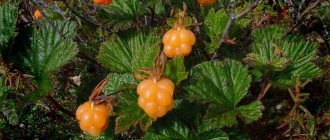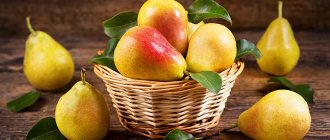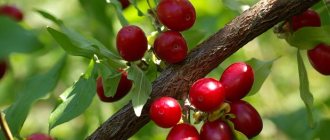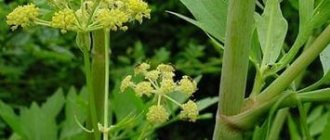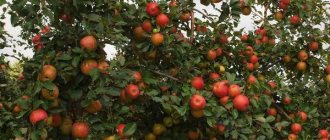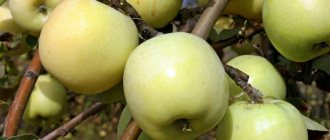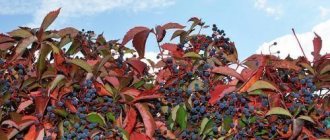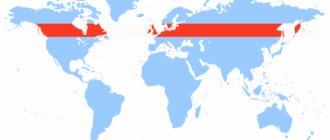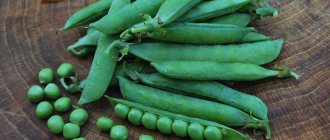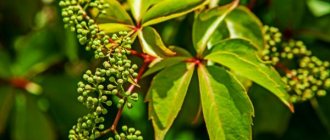Description of Chinese pear
The Chinese pear has many names - sellers often call it Japanese, shortbread, Taiwanese or neshi. It is known for certain that the variety was created on the basis of Yamanashi - a forest pear. The fruits of the ancestor, although large, were very sour and hard. Breeders, taking from Yamanashi's high adaptive abilities and frost resistance, endowed them with a new variety - neshi.
The Chinese pear, in comparison with its forest ancestor, has excellent taste. Today, neshi is popular not only among gardeners in China or Japan; this variety is grown in many countries. The main condition for growing is a suitable climate.
In Russia, conditions are favorable for us only in the south. But its hybrids, which are more resistant to frost, can bear fruit in the middle zone. Thus, a hybrid of Chinese and Far Eastern pears can withstand frosts down to -35 °C.
The taste of neshi fruits is considered unique. These pears are an excellent raw material for cooking. They are used to prepare desserts, make jam, and add to salads and baked goods.
Tree and fruit
Based on the wild pear, many varieties have been created that have inherited its frost resistance. All varieties, while having a lot of differences, have a set of common features:
- Great tree height. Subspecies of Chinese pear reach a height of 4-10 m. Trees of the classic variety are tall. But hybrids - they are grown in Russia, much lower.
- Self-fertility. Almost all subspecies of Nashi are self-fertile and do not require pollinators. The absence of pollinating pears does not affect the yield. But the appearance of the fruits is reflected in the fact that without pollinators they are smaller and uneven.
- Frost resistance. There are hybrids that can withstand low temperatures, others can survive the winter only in an insulated state - they are wrapped in straw or covered with spruce branches.
- Lifetime . The tree lives for about half a century. The lifespan of grafted trees is affected by the rootstock - with dwarf trees the tree lives up to 20 years, with vigorous trees - 50 years.
- Productivity. While the tree does not bear fruit, it quickly grows upward. When the fruits appear, the tree grows more slowly, and the yield gradually increases. By the 5th year of life, the tree produces up to 80 kg of fruit, and by the 30th year – up to 2 kg. Yields of up to 0.5 tons per tree have been recorded.
- Disease resistance. All varieties are characterized by high immunity. They practically do not suffer from scab, rot, parasites and infections.
- Cyclicity of fruiting. The tree is harvested annually. If pruning is done poorly, the plant loses strength and productivity.
Neshi fruits have an unusual shape - they are a cross between an apple and a pear. Features of Chinese pear fruits:
- The juicy and fragrant pulp has an excellent taste, combining sweetness and acidity. The aftertaste has spicy notes.
- The fruits have thin skin.
- Unripe nashi are sour and inedible. They are even dangerous for the body, as they contain a lot of organic acids.
- Color, depending on the variety, ranges from soft green to bronze.
- The average size is 4 cm in diameter.
- Weight – 120-300 g.
- Versatility - the fruit is delicious fresh and processed.
In stores, nash is usually sold in paper bags - in them, unripe fruits reach their condition. They are stored at room temperature, and after ripening - in the refrigerator.
Neshi fruits should not be eaten on an empty stomach. They are also not recommended to be combined with meat and dairy dishes.
Composition and calorie content
Neshi fruits have a calorie content typical of pears - 42 kcal per 100 g. These fruits do not contain starchy carbohydrates, so they are suitable for dietary nutrition. It is recommended to eat one piece of fruit three times a day.
100 g of fresh neshi fruit contains:
- water – 45 g;
- dietary fiber – 2 g;
- ash – 0.2 g;
- vitamins and minerals.
Chinese pear contains a lot of zinc, selenium, calcium, manganese, copper, and magnesium. Neshi fruits are especially rich in phosphorus and potassium. Moreover, this fruit contains five times more potassium than all other microelements. The fruits are also rich in choline, vitamins C and K.
Useful properties of nesha
The Chinese value the fruit for its high content of water, fiber, pectin and a huge amount of valuable microelements. In the Middle Kingdom, Nashi is used everywhere, from cooking to medicine and cosmetology. Where the Chinese pear tree grows, many Chinese cosmetic products, rubs, oils and ointments are made with essential oils and extracts from the neshi fruit.
Healing properties are irreplaceable:
- folic acid promotes tissue regeneration, it must be consumed by young girls who dream of healthy offspring;
- magnesium calms, normalizes sleep, strengthens the heart and blood vessels;
- fruit fiber saturates, absorbs harmful decay products, poisons and toxins and gently removes them from the intestines;
- potassium maintains an optimal balance of alkalis and acids in the body, strengthens the heart and blood vessels;
- pectins are famous for their ability to normalize blood pressure - hypertensive and hypotensive patients feel much better with regular use of the substance once or twice a week;
- fruit acids tone and cleanse blood vessels, neutralize the effects of poisons entering the body from the environment;
- calcium and phosphorus take an active part in strengthening musculoskeletal tissue: healthy bones, teeth, nails.
Vitamins play a huge role - their composition is well balanced, they complement each other’s actions, which is why the so-called synergistic effect is achieved. They improve brain activity, memory, regenerate body cells, and prevent cancer.
The Chinese believe that the Chinese fruit neshi is a rejuvenating apple that prolongs longevity and youth.
For adult women and men
For men and women, Chinese neshi helps maintain a toned figure and accelerate metabolic processes. Due to the low energy value of the fruit, nutritionists advise eating nash at least 2-3 times a week, eating it raw, baked, or making smoothies. The combination of fruits and cottage cheese is excellent. Why such desserts are useful is that they make you full for a long time, and you don’t want to lash out at the harmfulness. You can spend fasting days on a pear diet. It has been proven that they help you lose 1-2 kg in one day. The fruit is also credited with the ability to maintain potency - it is a strong natural aphrodisiac.
Since Chinese pear contains a huge amount of folic acid, it is recommended in preparation for pregnancy and during its first trimester. Pregnant women experience a double need for minerals and vitamins, and Nashi more than covers it without adding extra calories. Cosmetic masks made from grated fruits can be compared to fruit peeling in a light concentration - the skin looks fresher and younger.
For children
Children's delicate bodies are susceptible to viruses and colds, and Chinese pear naturally reduces body temperature and maintains optimal acid-base balance. Eating Chinese fruits is useful during the period of active growth - the musculoskeletal system becomes strong, and the immune system becomes hardened. The main thing is that the child is not allergic to fruits.
Pediatricians allow giving pears only after the child turns one year old - nashi are not suitable for early complementary feeding.
For the elderly
Very often, elderly people are advised to eat Chinese nashi. Firstly, to maintain mental clarity, and secondly, to prevent diseases of the urinary system. Chinese pear supports the kidneys and has a mild diuretic effect.
Pears strengthen the heart, keep blood vessels clean, clearing cholesterol plaques. The fruits also normalize blood pressure. Elderly Chinese start their day with a glass of fresh juice, and then feel cheerful all day long.
Advantages and disadvantages of the variety
European varieties of pears are undoubtedly tastier, juicier and more beautiful than their Chinese counterparts. But the latter have a lot of advantages that are important for our latitudes:
- resistance to weather disasters;
- high immunity;
- unpretentiousness to care and growing conditions;
- high and stable yields;
- frost resistance is much higher than that of European varieties;
- demand in cooking - durum varieties are good in salads, sauces and side dishes, they are stewed, baked, canned;
- high ability for vegetative propagation.
Disadvantages of the variety:
- insufficient keeping quality;
- The skin of ripe pears is easily damaged.
Variety varieties
Breeders have developed dozens of varieties of Chinese pear. The most winter-hardy and unpretentious varieties are grown in Russia. Gardeners choose Nashi, which are undemanding to soil, survive harsh winters, and withstand drought and pests. Let's take a closer look at the varieties that are the most popular among domestic gardeners.
Additional information about popular pear varieties for our region can be found here.
Kosu
Kosui is a summer variety that bears fruit in the second half of July. Advantages of the Kosu variety:
- frost-resistant;
- resistant to diseases and pests;
- early ripening - ripens earlier than all other Chinese varieties.
Medium-sized fruits - up to 160 g. Color - rich bronze. The pulp of the fruit is juicy - an ideal summer fruit.
Hosu
Hosui is a self-pollinating variety, but the presence of other varieties of Chinese pears nearby helps increase yields. The tree pleases its owners with fruits already in the second or third year of planting. The variety is considered an autumn variety, but harvesting begins in the second half of August. The fruits ripen unevenly, so harvesting is carried out in several stages. Cleaning ends in mid-September.
Advantages of the Hosu variety:
- pest resistance;
- frost resistance;
- large fruit;
- early ripening - pears appear in the 2-3rd year of planting;
- excellent taste, the pulp is juicy and sweet, contains up to 12% sugar.
The fruits weigh 160-200 g, but can reach 300 g. The color is rich bronze-brown. The pulp is dense - when cutting the fruit with a knife, you have to apply force.
Olympic
Olimpic is an autumn variety with excellent characteristics. Its advantages:
- early ripening - the tree bears fruit already in the 2nd year of planting;
- resistance to pests;
- frost resistance;
- not afraid of diseases, including scab and powdery mildew;
- quickly adapts to climate and soil;
- excellent taste characteristics, pleasant fruity aroma.
Olympic is also called the Great Korean Pear or the Korean Giant. The fruits of "Olympic" are round and have a pleasant golden hue. The entire surface is covered in small gray specks. Fruit weight – 160-200 g. The taste is original, xylo-sweet, the pulp is juicy. These pears are pleasant to eat fresh, they can also be stored - the fruits have excellent shelf life. Harvesting is in September.
Morning freshness
This summer variety is popular in the middle latitudes of Russia. It is partially self-fertile - to increase productivity, it is recommended to plant varieties of Chinese pears nearby - Bronze, Eastern Golden, Kieffer.
The variety tolerates frost well and has strong immunity to bacterial and fungal diseases. The fruits are small, weighing 100-150 g, they have a bright green skin covered with gray specks.
Khrustalnaya
Autumn early-fruiting variety. Already in 2-3 years the tree produces high yields. The variety is resistant to fungal infection. The fruits weigh 160-220 g, the color is light yellow. A distinctive feature is low calorie content. They have juicy but firm flesh. The taste is delicate, fruity.
Comparative table of popular varieties of neshi
| Variety | Fruiting begins | Average fruit weight, g | Harvest time | Shelf life |
| Kosu | for 2 years | 130-160 | second half of July – beginning of August | until September |
| Hosu | for 2-3 years | 150-200 | mid-August - second ten days of September | until November-December |
| Olympic | for 2 years | 160-200 | mid September | until January |
| Morning freshness | for 3-4 years | 100-150 | mid-August | 2-3 weeks |
| Khrustalnaya | for 3 years | 160 | September | till December |
Calories and nutritional value
Chinese pear has a low glycemic index, so many experts classify it as a dietary product. So, per 100 grams of fruit there are approximately 40-45 calories. The calorie content of one Chinese pear on average reaches 80-100 kcal and depends on its weight.
The calorie content of the fruit may vary, especially if it is processed. Dried fruit will already have about 250 Kcal per 100 grams.
As for the balance of BZHU, this ratio varies significantly. This type of pear is very rich in carbohydrates, which exceed the amount of fat and protein. Approximately 80-85% of the total number of BJUs are carbohydrates. About 3 grams of pears are dietary fiber. This fruit is considered watery and therefore ideal for people on a diet.
Pears contain a large amount of fructose, which significantly exceeds the amount of glucose. Chinese pear saturates the body with everything it needs, allowing you to forget about the feeling of hunger for a long time.
Landing Features
Caring for Chinese pears is not particularly different from caring for European varieties. The difference in agricultural technology is associated with the shape of the hybrids - for example, columnar varieties require more feeding and watering. These varieties have a less developed root system, their roots are located closer to the surface than those of ordinary pears.
Timing, place and climate
Nashi in the middle zone are planted in two ways:
- Saplings. Trees planted this way have a longer lifespan.
- Vaccination. The advantage of scions is early fruiting. But given the precociousness of all “Chinese”, this advantage is not taken into account.
Soil requirements:
- fertility;
- looseness;
- non-clayiness - sand is added to soils that are too clayey;
- normal acidity - the excess is compensated by the addition of limestone.
The timing of planting depends on the climate. Chinese pear can be planted in both spring and autumn. The main condition is warm weather. In temperate latitudes, for example, autumn planting is risky - the seedling may not survive the harsh winter.
Conditions for planting seedlings:
- Daytime temperatures should remain at +10 °C for some time.
- Planting is done before the buds swell and intense sap flow begins.
Although a number of Nashi hybrids can withstand frosts down to minus 30 °C, they cannot be planted in the northern regions. Firstly, the cold here is too long for Chinese pears, and secondly, they simply do not have time to ripen during the short summer.
Landing technology
The future productivity of the tree largely depends on the characteristics of the site. The landing site should:
- located on the south side;
- well lit;
- be on a hill.
If the above conditions are not observed, the yield is reduced, and the fruits themselves lose their taste appeal. And they become less beautiful in appearance - they turn pale.
Before planting a seedling, it must be soaked in water. Duration of soaking is 1-2 days. If there are damaged areas on the tree, they are removed with a sharpened tool.
The procedure for planting a seedling in the ground:
- In an area suitable for growing Chinese pear (sunny, on a hill, on the south side, etc.), dig a hole with a diameter and depth of 60 cm.
- The pits are prepared in the fall. Fertilizer is placed in it:
- humus – 6 kg;
- superphosphate – 60 g;
- potassium chloride – 15 g.
- Soil is poured on top of the fertilizer. If the soil is rich in elements such as copper, phosphorus, nitrogen, mineral additives may not be added.
- In spring, the soil is dug out of the hole and a mound is formed at the bottom. They put a peg to support the tree.
- Pre-soaked seedlings are placed in a hole, spreading the roots along the tubercle, and soil is poured on top. The tree should be planted so that its root collar rises 5 cm above the ground. After compacting the soil, tie the seedling to a support peg.
- Having formed a depression near the trunk, pour water into it - about 10 liters.
Many gardeners graft Chinese pears rather than plant them - the base can be Ussuri pear, birch-leaf, and ordinary rowan.
It is better to graft a pear onto a rootstock of your own species - then the scion will take root better and faster.
One-year-old seedlings are usually planted. But experienced gardeners recommend buying older seedlings – 2-3 years old. They take root no worse than annuals, and they bear fruit faster.
The spacing between adjacent seedlings depends on the rootstock. If the grafting is done on a vigorous rootstock, then a distance of about 3 m is left between the holes. If the rootstock is made from dwarf pear trees, then the distance is reduced to 1.5 m. Columnar pears are planted at intervals of 1 m or even less.
To which regions are varieties more adapted?
The classic Chinese pear is adapted to the southern regions.
In Russia it can only be grown in the far south.
However, hybrids developed since then have been successfully grown in temperate regions.
Despite the fact that some hybrids tolerate frosts down to -30 C, they cannot be planted in northern latitudes. Here the cold lasts too long and the summer is too short for fruit to ripen.
Pear care
A common feature of all varieties of Chinese pears is ease of care. The main thing is to water and feed the trees on time, as well as insulate them - if severe frosts are possible in the region.
Feeding
Fertilizers required for Chinese pear:
- Nitrogen. Pears do not need much nitrogen. To replenish the tree’s needs for this element, a little ammonium nitrate is added to the soil in the spring - 20 g per 1 sq. m. m. This is done every year during the first 3-4 years of the pear’s life. In the future, nitrogen is added if the need arises. Signs of nitrogen starvation: the tree is stunted;
- leaves are lighter than usual;
- depressed look;
- chopping leaves and fruits.
During the period of fruit appearance, the trees are fed with wood ash - 1-3 cups, adding it when loosening the trunk circles.
Watering
Methods for watering Chinese pear:
- Sprinkling. This is the best way to water a pear. With this system, water flows to the tree through a spray nozzle with many holes.
- Regular watering. A ditch is made near the tree trunk - 15 cm wide. Water is carefully poured into it.
Water the pear several times - in spring and summer, as needed. During drought periods, water more and more often. After watering, the soil is loosened to ensure oxygen access to the roots. When watering pears, the norm is three buckets per 1 square meter. m area of the trunk circle.
Rejuvenation and trimming
As trees age, they do not tolerate pruning well, but thanks to it it is possible to extend the life of the tree. Pruning is carried out on the threshold of warm weather - the main thing is to have time to trim the tree before the buds swell.
Principles of anti-aging pruning of Chinese pear:
- Rejuvenation involves thinning the crown. Excess branches must be removed - unhealthy ones, not bearing fruit, with mechanical and other damage.
- Having completed thinning, remove the contour shoots. Shoots that grow parallel to the crown or form an acute angle with it are also removed.
- Having removed the branches, the cuts are processed - garden pitch is used to coat them. This is done to prevent infection.
It is prohibited to remove more than a third of the branches in one pruning. If it is not possible to remove all the excess shoots before the sap begins to flow, rejuvenating pruning continues next spring.
Columnar varieties require virtually no pruning. The main thing is that the crown does not retain its shape. Other varieties of Nashi require minimal pruning:
- In the second year of life, all weakened branches are removed from the tree. Leave the 4 strongest ones - there should be the same distance between them.
- From an adult tree, only small and damaged branches are removed, as well as branches growing inside the crown.
Spring pruning is carried out at a temperature not lower than +5 °C. Winter pruning is carried out at minus 15 °C.
Forum statistics
207033 Messages in 1634 Topics from 5593 Users. Latest user: Amaya Latest message: “Ripening dates are different...” ( Today at 00:37:47 ) Latest messages on the forum.
Now on the forum
72 Guests, 5 Users
Users in the last 15 minutes: Alexander K, Tatyana A., Belgorodets, Anatoly Sivkov, in Astrakhan [Blocked] [Section Moderator] [Forum Moderator]
Maximum online today: 77 . All-time maximum online: 2758 (28 July 2021, 17:22:51)
Users who visited the forum in the last 24 hours
Total: 303
(Visible: 302, Hidden: 1) 1963, Alexander K, Tatyana A., Belgorodets, Anatoly Sivkov, in Astrakhan, hanter64, Oksana Kopp, Tatyana B, sem_en, Alex65, Vladimir 153, skier, Igor Viktorovich, slavalimon, Alexander Vl ., Primorets, OlgaOs, SANYCH, 31rus, mystic69, DorontsovPeter, Andrey Tsvetkov, Buba, Cherkessk, igor222, Andrey76, Ilya 77, Elena Z, vlad51, Kenig, Nikolay Rex, Sergey 1965, Vladimir Buturlakin, DSW, psv1960, Dmitry 77 , Vasily V., Vyacheslav03, Natalia Nikolaevna, Sergey Tashchiyan, Nikolay S., Igor Sergeevich, alexsandr, kvg, Pioneer, Ekaterina Polyanina, nicson7, Elena Aleshchenko, Alexander-ask-34, Verona, Igor F., Taker, Quiet, Henry, Yuri72, L.A.P., Gaivoronsky Yuri, Sergeevich, Sergei Chistokletov, Svetlana Streletskaya, Galinka, Alexey Deminov, Naumov Igor, Vyacheslav136, Vardan, Gloomy, Katrin, AndSanych, vladimirM, Mikhno Alexander, Ded31, Filippov Oleg, Vladimir ++, Svetla777, Alexey V, Mikhail Alekseevich, Lydia58, Mikhail77, ALEXANDER BRYANSKY, Vladimir-kanevskaya, leonidych, DIL, Amber7394, Andrey gladilin, Marina Protasova, TITOVA LYUBOV, Linx, alexander66, Natalya M, Mikhail Fesenko, ElenkaF, Amaya, Alexander71, Boris 1952, tsv, Maximilian, 25nata35, nadia, GALINA ANOKHINA, Igor_K, Alexander Kolesnikov, Ivan Levin, Pitko, weather forecaster, eSAa, cecet71, atseton, Alexander Smirnov, Vladimir Kostochkin, Vladimir Berdnikov, Gocha, pioneer-2 , mers, LeXa_KoT, Sergey 61, Sergey Yuryev, Erem, alexss, Evgeniy52, Skif, lomakin1969, Vladimir Kovba, dayton, Yuri Semyonov, N.A. Sokolov, Pavlentiy, Sa-shura, Volgogradka, Dmitry Anatolyevich, Grandfather Igor, Andrey Lis, Bublichenko Alexander M, Marina Krymskaya, stenlly2010, irahelm, Vyacheslav Vladimirovich, Vladimir Shilov, Aprel, Dmitry Badaev, gheo55, Yura, y_fed, rambo, Yagodka, Valentina Ivanovna, Kryn, oleg9f, DED2, Svetlana Korotina, Oleg Ivanovich Zavezen, Eduard., santra, L2k2m7n, Alexander48, Viknik, Andrey 31, m2d, Marshal, Valery Rastorguev, Serg1707, soshnin yura, Amateur gardener, Galina, vasily1111, gardener, marlin64, Salex, sergei, Sergey Ko, Ramiz, victor_, kosmos , potap05, Yuri 36, VitalySD, Inna161, Vova Kapran, Vladimir Shcherbinin, Valerie, niy1, cfibr, Andrey68, Elvira2017, kulol3, Slavka, thanatos, Serzh1978, Realist, Artur53, max2008-01, LOZA, AlexanderD, Grandfather Young, Natasha , Zayac, ketch, Rita, alx-74, Iv Iv, Alexander150, Igor K, SNovichek, Vasily Viktorovich, VeraNiK, kdm57, Veniaminovich, Boris Sokolyansky, therapist, Capricorn, 77volt, , vikbublik, neposny, Evgen, Victoria Aleksandrovna, Seryozha 64, Wintel, Airbone, teri, Sergey Lomonosov, Khramov, serginio, Leonty Yarygin, Irina O., Ser, Nadezhda Grig, zsb, Lyubov S., netolya, Saisan, Alexey Agryzkov, Vadi, Zinaida, Vadim, Alexander Taganrog, Sukhonos Sergey, Snezhinets, Evgen_26, NAU_63, Masha_Sadovod, Gennady163, Krasnovlad1, Alexander Zinoviev, Vasily 53, Roman Fedorovich, Tis, Alexey Sergeyevich, Arnyusha, Zhek, Nurtas, Kradievska, 64nikolay64, Nick041, Liza, Valentina Medvedeva, Sergey4 3, Andrey S. , Nikolay Lipunov, Mst, Vertuoz2, Vladimir VS, NatalyaMed, freesia, Kinna, Mikhail Michurinsk, alekcsan1, VALERY TAMB, Sasha57, MikhAf, Y_Azer, Andrey Beribesov, hunter1955, nut lover, Keys, Ivan Shmelev, Pestle, anton_slash, Nadymchanka, Sergey 31, Volgar, Pavel 64, Tatyana Volzh, Elektronik_t, Alexander 61, spotlight, Alexander Gai, Cheprak, Pirko Alexander, vladimirvrn, Antrikan, asun16, Alexey Viktorovich, YurSanych, bairina, Lekseich, yotmast, znakomij, Tatyana Provorova, Sergey Eliseev , Casperzrq, nidergvel
Diseases and pest control
Chinese pear is less vulnerable to pests and diseases. She is not afraid of scab, fungi, rust. And the only insect that can harm it is the flower beetle. Due to this durability, neshi does not require regular treatment with chemicals.
To prevent damage to trees by the flower beetle, preventive measures are taken:
- clean the trunks of old and damaged bark;
- they whiten the trunks;
- burn fallen leaves;
- They arrange sticky traps on the trunks.
Beetles are destroyed with insecticides, such as Intavir or Kinmiks.
Nashes are not planted near junipers - from them the tree can occasionally become infected with fungus. Fungal spores can fly 2 km or more.
How much can you eat in a day?
You can afford to eat several Chinese pears per day. It is better for pregnant women to reduce this amount to 1-2 fetuses per week. Do not eat pears on an empty stomach or before bed. They have diuretic properties and hence will lead to restless sleep.
Chinese pear is usually consumed fresh, since it is in this version that all the necessary substances are stored, including vitamins and amino acids. They often add it to cakes or make jam from it, but in this form it will not be so beneficial to the body.
If you want to follow a fruit diet, it is very important to agree with your personal nutritionist on the number of pears you will eat, as only he can determine how much and with what foods you should eat them.
Harvesting, storage and transportability
The collection is carried out taking into account the characteristics of the variety. Early ripening varieties ripen in mid-July, late ones in mid-September. Neshi fruits hold tightly to the branches, so when removing them, you need to make an effort and be extremely careful. The readiness of the fruit is determined by its color. Pears, depending on the variety, turn yellow or bronze. The skin should be thick and clean.
The collected fruits require careful handling. Each pear is wrapped in paper and laid - in a maximum of three rows. Pears are placed in the refrigerator in the same way - with each fruit packed. Varieties of neshi differ in their keeping quality. So, it is recommended to eat Kosu early, and Olympic remains until the New Year without losing its taste and smell.
Neshi fruits, unlike ordinary ones, retain their density for a long time. But they are quite sensitive to shocks and blows - at the site of the bruise, the skin changes color, and the fruit loses its presentation. That is why each pear is packaged separately.
Recommendations for use and application
You can eat Chinese pear like other fruits. You can eat it fresh, make jam , filling for baked goods, add it to ice cream, desserts, fruit salads.
Nashi goes well with Asian dishes and is a good appetizer for sake.
There are no restrictions on the amount of pear, but you still need to know when to stop. 500 g of tasty, ripe fruits will be enough to enjoy the unique taste and provide the body with useful substances.
It is better to eat fruits in the first half of the day , but not at night, as they have a diuretic effect.
How are radishes good for pregnant women? Can a vegetable harm an expectant mother? Find answers to your questions in our article.
The medicinal properties of red currant and its use in folk medicine are discussed in this material.
Read about the beneficial properties and contraindications of raspberries in this publication.
In cooking
Here are some simple and interesting recipes using neshi.
Chinese pear in sake and warm chocolate sauce . For the recipe you will need 600 ml of water, 8 tablespoons of sake, 2 pcs. anise, two limes, 2 pears, 150 ml cream, 75 g dark chocolate, 50 g butter, cinnamon stick.
Pour water, sake into a saucepan, add the juice and zest of one lime, anise and cinnamon. Let it boil. Simmer for five minutes, then reduce heat.
Add the whole, peeled pears, cover and simmer for 45 minutes until softened. Remove from heat and leave to cool in syrup.
To prepare the sauce, melt the chocolate and mix it with butter and cream. Then add the zest of another lime and mix thoroughly.
Cut the pears in half and remove the inside. Place in serving bowls and pour over the resulting chocolate syrup.
Salad with cheese and arugula . A very spicy salad, for which you will need 2 pieces each of Chinese and Conference pears, 150 g arugula, one lemon, 150 ml dry white wine, 250 g pine nuts, 50 g sheep cheese, sea salt, ground black pepper, butter grape seeds - to taste.
Rinse the arugula leaves and dry. Wash the pears, peel, cut, remove the middle and stem. Cut every fourth part in half. Cut the resulting parts lengthwise into half-centimeter fragments. Sprinkle with lemon juice.
Heat up the frying pan. Pour the wine there in a centimeter layer. After heating it, add cane sugar and let it dissolve. Then the wine should evaporate by half.
Place the Conference into the pan. Cook over high heat until the wine almost completely evaporates and the fruit becomes dark and soft.
Cut the cheese into thin slices. Place arugula on dry plates, followed by roasted conference pears, fresh nash and cheese.
Pour over oil and sprinkle with lemon juice. You can sprinkle with pine nuts. Add salt and pepper to taste.
For weight loss
The low calorie content of the Chinese pear and many useful components make it a wonderful addition to the diet.
A couple of fruits are a good snack that will help you get rid of hunger for several hours.
Nashi will satisfy your sweet tooth without the risk of gaining extra pounds. These fruits are much healthier than chocolate or cakes, and there are ten times fewer calories.
Therefore, if you are watching your figure, make it a rule to replace unhealthy sweets with juicy, tasty fruits .
In medicine
It is recommended for use by those who suffer from functional digestive disorders.
The fruit will help normalize the heart rhythm, improve well-being, and relieve nervous tension. Juices and compotes based on nasha help in the fight against diarrhea.
Chinese pear juice is recommended for diabetics as it normalizes blood sugar levels. Start with 50 mg and gradually increase the dose to one glass. It is recommended to drink juice 30 minutes before eating.
Boiled and baked pears, thick decoctions based on them help with severe coughing, accompanied by attacks of suffocation.
Both raw fruits and juices and decoctions based on them help remove excess fluid from the body, strengthen the walls of veins and capillaries, and prevent varicose veins and heart problems.
Chinese pears almost do not accumulate chlorine and sodium, which is why they are useful for kidney pathologies and can be included in salt-free diets.
Benefits and contraindications
Chinese pear is valued by nutritionists - this product is indispensable for weight loss. Only Nashi fruits are the only ones of all pear varieties that can be combined with fermented milk products.
Nashi fruits contain a lot of:
- ascorbic acid – to improve immunity;
- essential oils - for a diuretic effect;
- antioxidants - to prevent aging;
- vitamin PP - to improve blood circulation and strengthen blood vessels;
- B vitamins - to strengthen the nervous system;
- vitamins E and K - to balance hormonal balance, prevent atherosclerosis and skin aging.
Chinese pears are recommended for:
- diseases of the gastrointestinal tract;
- tuberculosis;
- constipation;
- liver diseases;
- consequences of alcohol intoxication;
- cough, bronchitis, throat diseases;
- diabetes
Benefits of eating neshi fruits:
- help digest food;
- cleanse the intestines;
- prevent the formation of stones and blood clots;
- improve the functioning of the heart muscle;
- normalize blood pressure;
- strengthen bone tissue;
- lower cholesterol.
Nashi pears are effective as a cleanser for smoking and unhealthy food abuse.
The Chinese pear, despite its unusual commercial characteristics, has every chance of becoming one of the most popular varieties in central Russia. Nashi attracts gardeners with its high level of adaptation and unpretentiousness, as well as the original taste and aromas of the fruit.
0
0
Copy link
Description of the fruit: calorie content - BJU, glycemic index
Chinese pears are shaped like a cross between an apple and a regular pear. The peduncle is short brown. The fruit is held firmly on the branch. The fruit is recommended for dietary nutrition, as it does not contain starchy carbohydrates and is rich in vitamins. The taste of the Chinese pear is noticeably superior to the taste of its “ancestor”. The softness is juicy and fragrant, peach-colored, uniform, but not soft. The harmonious taste combines sourness and sweetness, the aftertaste includes characteristic spicy notes. Stores most often offer unripe fruits that need to be “kept” for some time. To do this, the fruit is placed in a paper bag. It is best together with a banana and an apple, since the pear ripens faster next to other fruits. Store at room temperature. When the fruit is ripe, it is put into the refrigerator. Read about the calorie content of pears in this article.
Unripe neshi has a sour, extremely inedible taste and is even dangerous to health due to its high content of organic acids.
Fruit sizes, benefits and harms
Fruit size - on average, a pear reaches a diameter of up to 4 cm. Depending on the variety, the weight of a mature fruit ranges from 120 to 300 g.
Pear should not be eaten on an empty stomach as it can be harmful. It also does not go well with dairy and meat dishes.
In cooking, Chinese pears are used to prepare fillings for cakes and pies, as well as a component of fruit salad. The fruit is also suitable for preservation: it is used to make compotes, preserves and jams, which have a wonderful smell. Fruits are also added to ice cream, yogurt and kefir, since this is the only type of pear that, when combined with fermented milk products, benefits the body.
Chinese pear is a universal variety. It is consumed both fresh and cooked.
About the glycemic index, whether pregnant women can eat (during pregnancy) and caloric content (how many calories, carbohydrates, proteins, fats) it is better to read in more detail in the description of the variety.
The pear should not be used to feed small children. It is introduced into the diet only when the child reaches 3 years of age.

